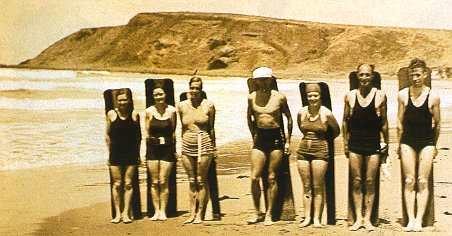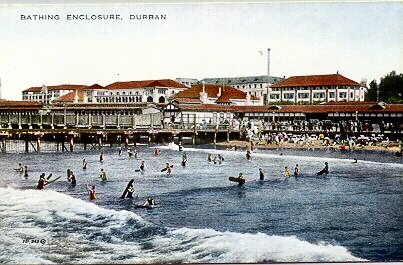 |
surfresearch.com.au
the catalogue #233 |
| home | catalogue | history | references | appendix |
|
|
|||||||||||||||||||||||||||||||||||||||||||||||||
 |
|||||||||||||||||||||||||||||||||||||||||||||||||
| MANUFACTURE
MANUFACTURER: Unknown SHAPER: Unknown DESIGN: Lamaroo/Paipo/Belly Board DESIGNER: Unknown |
|||||||||||||||||||||||||||||||||||||||||||||||||
| SPECIFICATIONS
CONSTRUCTION Timber board with (steamed) turned up nose. Painted. DIMENSIONS
Nose: square Tail: Square Deck: Flat Bottom: Flat Rails: rounded square Rocker: substantial nose lift, flat |
|||||||||||||||||||||||||||||||||||||||||||||||||
| FIN/S: none | |||||||||||||||||||||||||||||||||||||||||||||||||
|
|||||||||||||||||||||||||||||||||||||||||||||||||
| NOTES
HISTORY Added to surfresearch collection March 2008. Item said to be from a house on or near Phillip Island, Victoria. COMMENTS Solid timber handboards/bellyboards were in use on Sydney's beaches before the visit of Duke Kahanamoku in 1914 - see History/Duke/Detailed Analysis. The enthusiasm generated by this visit saw Sydney surfers persue the developement of the standing board and prone craft were dominated by the Surf-o-plane, circa 1933.These boards were in Victorian use as early as 1915, by a Mr. Jackson and Mr. Goldie at Point Lonsdale, after a visit to Hawaii. They were either imported or homemade adaptations and in 1915 they encouraged a local girl, Grace Smith Wootton, to take up the sport. Plans of solid timber prone boards were pulished in Popular Mechanics magazine July 1934 and Popular Science magazine August 1935.These illustrated that such boards were already in use in the USA and publication in such magazines probably saw these plans distrubuted world wide. The design was popular in the southern states of Australia and in New Zealand, South Africa and UK. Although many were probably home made, this and several New Zealand examples were probably factory made - note regular shape, nose lift and paint decor. REFERENCES Other Boards Surfworld Museum, Torquay Victoria. : Lamaroo # 26 Also see Paipo Catalogue Books Wells pages 157 - 159 Edmunson pages157 - 167, note Figures 51 and 52. CONDITION: 7.5 
|
|||||||||||||||||||||||||||||||||||||||||||||||||
| OTHER LAMAROOS
Prout brand solid wood belly board, New Zealand 1940's 5ft from Longboard Surfshop (NZ) On-line Auction catalogue, 1999.

Lamaroos at Phillip Island, Victoria 1935. Note that two boards to the left appear to be laminated sections. from Two Hundred Years, No. 47 page 1124 
Postcard : Timber prone boards, Durban, South Africa circa 1950. |
|||||||||||||||||||||||||||||||||||||||||||||||||
 |
|||||||||||||||||||||||||||||||||||||||||||||||||

surfresearch.com.au |
| home | catalogue | history | references | appendix |